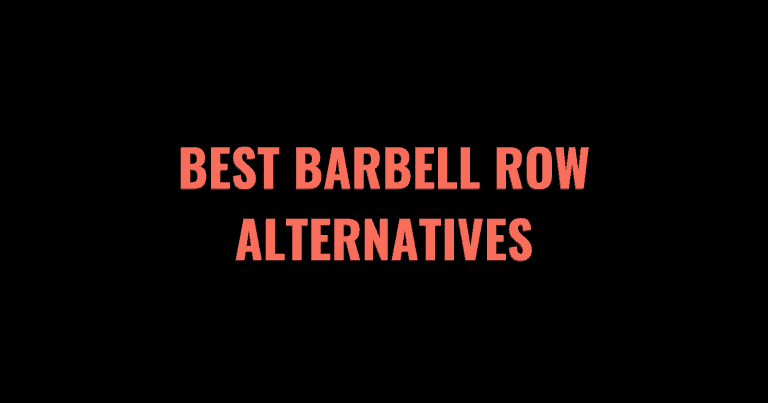The bench press is a staple of many strength and hypertrophy programs for beginners and experienced weightlifters alike. The decline bench press variation involves lying on a bench with your hips higher than your head. Bench pressing from a declined position effectively activates your lower pecs and triceps while putting less strain on the lower back and anterior delts.
If you don’t have access to a decline bench or a spotter or simply don’t like how decline bench presses feel, there are plenty of equally effective exercises.
Here is our list of the best decline bench press alternatives for days when all the decline bench stations are taken, you have limited access to equipment, or are wanting to change up your exercise selection.
Table of Contents
- 1 The 8 Best Decline Bench Press Alternatives
- 2 2. Decline Floor Presses
- 3 3. Decline Dumbbell Flyes
- 4 4. Dumbbell Chest Pullovers
- 5 5. Decline Machine Chest Presses
- 6 6. Parallel Bar Chest Dips
- 7 7. Underhand Grip Incline Push-Ups
- 8 8. Seated Cable Decline Chest Presses
- 9 Reasons to Choose a Decline Bench Press Alternative
- 10 Muscles Worked by Decline Bench Presses
- 11 Decline Bench Press Alternatives: FAQs
- 12 Other Alternative Exercises
- 12.1 The 10 Best Front Squat Alternatives
- 12.2 The 10 Best Box Jump Alternatives
- 12.3 The 10 Best Overhead Press Alternatives
- 12.4 The 8 Best Tricep Dip Alternatives
- 12.5 The 10 Best Lat Pulldown Alternatives
- 12.6 The 10 Best Bulgarian Split Squat Alternatives
- 12.7 The 9 Best Barbell Row Alternatives
- 12.8 The 9 Best Lunge Alternatives
- 12.9 The 9 Best Seated Cable Row Alternatives (2023)
- 12.10 The 10 Best Dumbbell Pullover Alternatives
- 12.11 The 10 Best Bent Over Row Alternatives
- 12.12 The 10 Best Leg Extension Alternatives
- 12.13 The 10 Best Hack Squat Alternatives
- 12.14 The 10 Best Pallof Press Alternatives
- 12.15 The 9 Best Leg Press Alternatives
The 8 Best Decline Bench Press Alternatives
- Decline Dumbbell Presses
- Decline Floor Presses
- Decline Dumbbell Flyes
- Dumbbell Chest Pullovers
- Decline Machine Chest Presses
- Parallel Bar Chest Dips
- Underhand Grip Incline Push-Ups
- Seated Cable Decline Chest Presses
1. Decline Dumbbell Presses
If pressing a barbell from a decline bench position is uncomfortable, dumbbells might feel more natural for your biomechanics. Decline dumbbell presses are the closest alternative to decline bench presses and similarly target the lower pec region. Dumbbells allow you to press the weight up and inward, moving the chest through a fuller range of motion.
How to Perform Decline Dumbbell Presses
- Adjust a bench so that it is at a 30-degree decline. Lay down on the bench with your hips higher than your head. Secure your feet in place for support and stability.
- Hold a dumbbell in each hand directly above your chest with your arms extended.
- Engage your abdominals and pull the dumbbells down towards your chest and slightly out to the sides.
- Pause when the dumbbells hover just above your chest, and you feel a stretch in your pecs.
- Squeeze your chest and triceps to press the dumbbells up to their starting position.
- Repeat for the desired number of sets and reps.
This video from Bodybuilding.com provides a helpful visual guide for performing decline dumbbell presses.
Tips for Decline Dumbbell Presses
Keep a straight movement path with your dumbbells by ensuring you press them up directly above your sternum, not your face. Lock your shoulders in place to ensure the dumbbells move in the correct plane. Control the eccentric (lowering) portion of the lift by slowing it down as much as possible.
2. Decline Floor Presses
When to Perform Decline Floor Presses
Decline floor presses are a great way to replicate decline bench presses without a bench. By holding a glute bridge position, you use your leg and glute muscles to mimic the position of a decline bench. Holding your hips above your head as you press the dumbbells engages your lower pecs. This minimal equipment variation also has the added benefit of strengthening your glutes, legs, and core while you train your chest.
How to Perform Decline Floor Presses
- Lie on the ground with a dumbbell in each hand. Bend your knees and plant your feet firmly about a foot away from your glutes.
- Hold the dumbbells with a pronated grip directly above your chest.
- Squeeze your glutes and hamstrings to lift your hips high until your body forms a straight decline from your knees to your chest.
- Hold your lower body in position as you lower the dumbbells towards your chest. Stop when your elbows graze the floor or when you feel your pecs stretch.
- Squeeze your chest and triceps to press the dumbbells back up.
- Repeat for the desired number of sets and reps, only lowering the hips at the end of each set.
For a visual aid, check out this video from Leap Fitness.
Tips for Decline Floor Presses
Control the movement from start to finish and do not bounce the elbows off the ground to press the dumbbells up. Use your muscles, not your momentum, and slow down your reps, especially during the eccentric (lowering) phase, to increase time under tension.
3. Decline Dumbbell Flyes
When to Perform Decline Dumbbell Flyes
Dumbbell flyes stretch your pec muscles more than almost any other dumbbell chest exercise. Engaging your muscles in a stretched position creates significant muscular damage, which is a key driver of muscular hypertrophy. You can do dumbbell flyes on a flat bench, but using a decline will more closely replicate the decline bench press and better engage your lower pecs.
How to Perform Decline Dumbbell Flyes
- Lie on a bench set up at a 30-degree decline. Hold a pair of dumbbells in your hands with a neutral grip (palms face each other). Raise the dumbbells directly above your mid-chest.
- Keep your arms locked in an extended position but maintain a micro bend in the elbows. Retract your scapula and brace your abdominals.
- Lower the dumbbells out to your sides to fly the arms open. Rotate your arms slightly so your hands face the ceiling at the bottom of the exercise.
- Pause when your upper arms align with your torso, and you feel a stretch in your pecs.
- Squeeze your chest and triceps to reverse the movement and bring the dumbbells back together above your chest.
- Repeat for the desired number of sets and reps.
Check out this video from Livestrong.com for a visual guide to performing the decline dumbbell fly.
Tips for Decline Dumbbell Flyes
To target your lower pecs with the dumbbell fly, keep your dumbbells in line with your sternum. This position is slightly lower than you would normally use for a chest fly, which makes it more effective at targeting your lower chest muscles. To do this exercise without a bench, lie on the ground and lift your hips similarly to a floor decline press.
4. Dumbbell Chest Pullovers
When to Perform Dumbbell Chest Pullovers
Dumbbell pullovers excel at training your chest because they move the muscles through an arc, allowing them to stretch and contract effectively. Dumbbell pullovers are not a perfect alternative to decline bench presses because they don’t isolate the lower chest. They target your pecs, serratus anterior, and lats. They also engage the delts, triceps and biceps to a lesser degree, contributing to a stronger and bigger overall chest.
How to Perform Dumbbell Chest Pullovers
- Lie down on a flat bench or the ground with a dumbbell in each hand.
- Hold the dumbbell above your chest with a slight bend in your elbows. Pull your shoulder blades back and down and brace your core.
- Lower the dumbbell behind your head until your arms are parallel to the ground and you feel a stretch in your lower pecs.
- Squeeze your chest and lats to pull the dumbbell back to its starting position above your chest.
- Repeat for the desired number of sets and reps.
Check out this video from Colossus Fitness for a visual guide to performing the dumbbell chest pullover.
Tips for Dumbbell Chest Pullovers
Keep your elbows slightly bent throughout this exercise. Do not increase the bend in your elbows as your arms move overhead. Excessively bending the elbows shifts the emphasis away from your pecs and engages the triceps similarly to a skull crusher.
5. Decline Machine Chest Presses
When to Perform Decline Machine Chest Presses
If your gym has a decline chest press machine, it makes a great alternative. Compared with the traditional decline bench press, decline chest press machines are easy to set up and very beginner-friendly. They position your torso in a slightly reclined seated position to target the lower pectorals. Standard chest press machines are easier to find but less effective at isolating your lower chest. Decline chest press machines are a great but less common piece of equipment that can provide a safe and comfortable alternative to decline bench presses.
How to Perform Decline Machine Chest Presses
- Sit on the decline chest press machine and secure your hips using the seatbelt if provided.
- Grip the handles outside your chest with an overhand grip. Brace your abdominals and keep your gaze straight ahead to keep a neutral spine.
- Squeeze your pecs to initiate the movement and press the handles away from you.
- When you reach full extension of the arms, reverse the movement slowly and with control. Think about pulling the handles back towards you rather than letting them drop.
- Lower the handles until your pecs are in a stretched position, and repeat.
- Perform as many reps and sets as desired.
For a visual guide to performing the decline machine chest press, here’s a useful video.
Tips for Decline Machine Chest Presses
Machine exercises are great for lifting heavy weights without the risk of dropping barbells or dumbbells. Unfortunately, this gives rise to ego lifting or pushing more weight than you can do with proper form. Choose your weight carefully. Avoid bouncing the weight out of the bottom of the rep, which will use momentum rather than your muscles.
6. Parallel Bar Chest Dips
When to Perform Parallel Bar Chest Dips
Dips performed on parallel bars are better for targeting your pecs compared to horizontal or bench dips. Dips are great for loading the chest, shoulders, and triceps through a long range of motion and activating numerous muscle fibers. To make chest dips a more effective alternative to decline bench presses, lean your torso forward slightly to recruit more of the lower pectoralis major.
How to Perform Parallel Bar Chest Dips
- Stand between two parallel bars. Grab the bars and jump up so your body is hovering off the ground.
- Retract your shoulders and ensure they don’t roll forward during the exercise. Tuck your chin and look straight in front of you to protect the upper spine.
- Lean your torso forward slightly to target the lower pecs.
- Lower your body towards the ground by bending at the elbows and allowing them to travel behind you.
- Keep lowering yourself until your shoulders are parallel to your elbows or slightly lower.
- Press through your hands to straighten the arms and lift yourself back to the starting position.
- Repeat for the desired number of sets and reps.
This video from Jeff Nippard provides a great overview of the dip, how to master the technique, and variations to target your chest and shoulders.
Tips for Parallel Bar Chest Dips
Once you can do big sets of bodyweight parallel dips, progress the exercise by adding a weight belt or holding a dumbbell between your knees. Conversely, if you can’t do bodyweight dips, use assistance from a dip machine, resistance bands, or perform negative (eccentric) reps to build the strength and mobility required for chest dips.
7. Underhand Grip Incline Push-Ups
When to Perform Underhand Grip Incline Push-Ups
Incline pushups are a great alternative to the decline bench press that you can do without any equipment. Elevating your hands on a surface like a flat bench or piece of furniture helps you to target the chest more effectively. Rotating your hands to use an underhand grip makes the exercise similar to a decline bench press and better isolates the lower pectorals.
How to Perform Underhand Grip Incline Push-Ups
- Stand in front of an elevated platform like a flat bench, barbell in a squat rack, or the back of a couch or other piece of sturdy furniture.
- Place your palms on the platform with your wrists rotated so that your fingers face your torso.
- Assume an inclined plank position so your core is engaged and your body is in one straight line.
- Bend your elbows and allow them to travel behind you to lower your torso until the platform grazes your chest.
- Squeeze your pecs and triceps to press back into your starting position.
- Repeat for the desired number of sets and reps.
For a visual guide to underhand grip incline push-ups, check out this video from Aaron Bilecki Fitness.
Tips for Performing Underhand Grip Incline Push-Ups
Protect your shoulders by tucking your elbows close into your body. As you build strength in this push-up variation, you can experiment with less of an incline or add a weight vest for more resistance.
8. Seated Cable Decline Chest Presses
When to Perform Seated Cable Decline Chest Presses
Cable machines are a great tool for training the chest muscles in their fully stretched position. Using a double cable machine replicates the downward angle of a decline bench press without needing a bench. Pressing the cables out and towards each other works the pecs and triceps similarly to decline bench presses, without the complex set-up.
How to Perform Seated Cable Decline Chest Presses
- Sit on a reclined seat or bench in front of a dual cable machine tower. Plant your feet firmly and brace your abdominals for stability.
- If adjustable, set the cable machine so the pulley is in line with your shoulders.
- Grab the handles with an overhand grip and hold them just below your chest.
- Squeeze your chest to press the cable handles forward and towards each other to engage the pecs.
- Pause when your arms are extended, but maintain a slight bend in the elbow.
- Slowly return the handles to their starting position, maintaining control of the movement at all times.
- Stop when you feel a stretch in your chest.
- Repeat for the desired number of sets and reps.
Check out this useful video from HASFit for a visual guide to performing the seated cable decline chest press.
Tips for Performing Seated Cable Decline Chest Presses
Get the most out of this exercise by paying close attention to your posture. Avoid arching your back as this will reduce your range of motion and make the exercise less effective at engaging your pecs. Keep your wrists aligned with your forearms by actively gripping the handles to protect the wrist joint and target the correct muscle groups.
Reasons to Choose a Decline Bench Press Alternative
EMG studies have found the decline bench press to be particularly effective at engaging the lower pecs when compared to standard flat bench presses. Effective alternatives should emphasize the lower pectoral muscles and recruit the triceps and anterior deltoids.
One of the major benefits of decline bench presses is their ability to emphasize the chest without straining the shoulder joint or lower back. When selecting alternative exercises, ensure you can work your chest without straining other muscles or joints in your upper body.
Muscles Worked by Decline Bench Presses
Decline bench presses primarily target the lower section of your pectoralis major. Your triceps and anterior deltoid are also involved. Your abdominals and biceps play a minor role in assisting and stabilizing your upper body during the lift.
- Primary muscles used: Pectoralis Major (Lower), Triceps
- Secondary muscles used: Anterior Deltoid
- Assisting/stabilizing muscles: Biceps Brachii, Abdominals
Decline Bench Press Alternatives: FAQs
Can you isolate just the lower chest muscles?
No. Chest exercises, like the decline bench press, recruit your entire chest to lift the weight. However, decline bench presses do engage more muscle fibers in your lower pectoralis major compared to incline or flat bench presses. Performing bench presses with your bench at a 30-degree decline effectively builds size and strength in your lower chest area.
How can I work my lower chest muscles without a bench?
Positioning your hips above your chest activates the lower pectoralis major in horizontal pressing exercises. To replicate this movement pattern without a bench, you can do pushups on an incline, such as a plyometric box or the back of a couch. Rotate your wrists, so your fingers face your body to recruit the lower pectorals. For a weighted option, you can do floor dumbbell chest presses whilst holding a glute bridge position to emphasize the lower chest muscles.
See also: lower chest cable exercises
Other Alternative Exercises
If you enjoyed this post, check out our other roundups of the best alternatives for other exercises.













